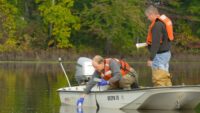NPDES permits can include limits for PFAS effluent, EPA encourages state action
Memorandum describes steps permit writers can implement under existing authorities to reduce PFAS discharge.

Photo by the Environmental Protection Agency
The National Pollutant Discharge Elimination System (NPDES) program is an important tool established by the Clean Water Act (CWA) to help address water pollution by regulating point sources that discharge pollutants to waters of the United States. Collectively, the U.S. Environmental Protection Agency (EPA) and states issue thousands of permits annually, establishing important monitoring and pollution reduction requirements for Publicly Owned Treatment Works (POTWs), industrial facilities, and stormwater discharges nationwide. The NPDES program interfaces with many pathways by which per-and polyfluoroalkyl substances (PFAS) travel and are released into the environment, and ultimately impact water quality and the health of people and ecosystems. Consistent with the Agency’s commitments in the October 2021 PFAS Strategic Roadmap: EPA’s Commitments to Action 2021-2024 (PFAS Strategic Roadmap), EPA will work in cooperation with our state-authorized permitting authorities to leverage the NPDES program to restrict the discharge of PFAS at their sources. In addition to reducing PFAS discharges, this program will enable EPA and the states to obtain comprehensive information on the sources and quantities of PFAS discharges, which can be used to inform appropriate next steps to limit the discharges of PFAS.
This memorandum provides EPA’s guidance to states and updates the April 28, 2022 guidance to EPA Regions for addressing PFAS discharges when they are authorized to administer the NPDES permitting program and/or pretreatment program. These recommendations reflect the Agency’s commitments in the PFAS Strategic Roadmap, which directs the Office of Water to leverage NPDES permits to reduce PFAS discharges to waterways “at the source and obtain more comprehensive information through monitoring on the sources of PFAS and quantity of PFAS discharged by these sources.” While the Office of Water works to revise Effluent Limitation Guidelines (ELGs) and develop water quality criteria to support technology-based and water quality-based effluent limits for PFAS in NPDES permits, this memorandum describes steps permit writers can implement under existing authorities to reduce the discharge of PFAS.
This memorandum also provides EPA’s guidance for addressing sewage sludge PFAS contamination more rapidly than possible with monitoring based solely on NPDES permit renewals. States may choose to monitor the levels of PFAS in sewage sludge across POTWs and then consider mechanisms under pretreatment program authorities to prevent the introduction of PFAS to POTWs based on the monitoring results. EPA recommends that the following array of NPDES and pretreatment provisions and monitoring programs be implemented by authorized states and POTWs, as appropriate, to the fullest extent available under state and local law. NPDES and pretreatment provisions may be included when issuing a permit or by modifying an existing permit pursuant to 40 CFR 122.62.
Recommendations for applicable industrial direct dischargers
- Applicability: Industry categories known or suspected to discharge PFAS as identified on page 14 of the PFAS Strategic Roadmap include: organic chemicals, plastics & synthetic fibers (OCPSF); metal finishing; electroplating; electric and electronic components; landfills; pulp, paper & paperboard; leather tanning & finishing; plastics molding & forming; textile mills; paint formulating, and airports. This is not an exhaustive list and additional industries may also discharge PFAS. For example, Centralized Waste Treatment (CWT) facilities may receive wastes from the aforementioned industries and should be considered for monitoring. There may also be categories of dischargers that do not meet the applicability criteria of any existing ELG; for instance, remediation sites, chemical manufacturing not covered by OCPSF, and military bases. EPA notes that no permit may be issued to the owner or operator of a facility unless the owner or operator submits a complete permit application in accordance with applicable regulations, and applicants must provide any additional information that the permitting authority may reasonably require to assess the discharges of the facility (40 CFR 122.21(e), (g)(13)). The applicant may be required to submit additional information under CWA Section 308 or under a similar provision of state law.
- Effluent and wastewater residuals monitoring: In the absence of a final 40 CFR Part 136 method, EPA recommends using CWA wastewater draft analytical method 1633 (see 40 CFR 122.21(e)(3)(ii) and 40 CFR 122.44(i)(1)(iv)(B)). EPA also recommends that monitoring include each of the 40 PFAS parameters detectable by draft method 1633 and be conducted at least quarterly to ensure that there are adequate data to assess the presence and concentration of PFAS in discharges. All PFAS monitoring data must be reported on Discharge Monitoring Reports (DMRs) (see 40 CFR 122.41(l)(4)(i)). The draft Adsorbable Organic Fluorine CWA wastewater method 1621 can be used in conjunction with draft method 1633, if appropriate. Certain industrial processes may generate PFAS-contaminated solid waste or air emissions not covered by NPDES permitting and permitting agencies should coordinate with appropriate state authorities on proper containment and disposal to avoid cross-media contamination. EPA’s draft analytical method 1633 may be appropriate to assess the amount and types of PFAS for some of these wastestreams. Click here for a list of EPA approved methods for other media.
- Best Management Practices (BMPs) for discharges of PFAS, including product substitution, reduction, or elimination of PFAS, as detected by draft method 1633: Pursuant to 40 CFR 122.44(k)(4), EPA recommends that NPDES permits for facilities incorporate the following conditions when the practices are “reasonably necessary to achieve effluent limitations and standards or to carry out the purposes and intent of the CWA.”
- BMP conditions based on pollution prevention/source reduction opportunities, which may include:
- Product elimination or substitution when a reasonable alternative to using PFAS is available in the industrial process.
- Accidental discharge minimization by optimizing operations and good housekeeping practices.
- Equipment decontamination or replacement (such as in metal finishing facilities) where PFAS products have historically been used to prevent discharge of legacy PFAS following the implementation of product substitution.
- Example BMP permit special condition language:
- PFAS pollution prevention/source reduction evaluation: Within 6 months of the effective date of the permit, the facility shall provide an evaluation of whether the facility uses or has historically used any products containing PFAS, whether use of those products or legacy contamination reasonably can be reduced or eliminated, and a plan to implement those steps.
- Reduction or Elimination: Within 12 months of the effective date of the permit, the facility shall implement the plan in accordance with the PFAS pollution prevention/source reduction evaluation.
- Annual Report: An annual status report shall be developed which includes a list of potential PFAS sources, summary of actions taken to reduce or eliminate PFAS, any applicable source monitoring results, any applicable effluent results for the previous year, and any relevant adjustments to the plan, based on the findings.
- Reporting: When EPA’s electronic reporting tool for DMRs (called “NetDMR”) allows for the permittee to submit the pollution prevention/source reduction evaluation and the annual report, the example permit language can read, “The pollution prevention/source reduction evaluation and annual report shall be submitted to EPA via EPA’s electronic reporting tool for DMRs (called “NetDMR”).
- BMP conditions based on pollution prevention/source reduction opportunities, which may include:
- BMPs to address PFAS-containing firefighting foams for stormwater permits: Pursuant to 122.44(k)(2), where appropriate, EPA recommends that NPDES stormwater permits include BMPs to address Aqueous Film Forming Foam (AFFF) used for firefighting, such as the following:
- Prohibiting the use of AFFFs other than for actual firefighting.
- Eliminating PFOS and PFOA -containing AFFFs.
- Requiring immediate clean-up in all situations where AFFFs have been used, including diversions and other measures that prevent discharges via storm sewer systems.
- Permit Limits: As specified in 40 CFR 125.3, technology-based treatment requirements under CWA Section 301(b) represent the minimum level of control that must be imposed in NPDES permits. Site-specific technology-based effluent limits (TBELs) for PFAS discharges developed on a best professional judgment (BPJ) basis may be appropriate for facilities for which there are no applicable effluent guidelines (see 40 CFR 122.44(a), 125.3). Also, NPDES permits must include water quality-based effluent limits (WQBELs) as derived from state water quality standards, in addition to TBELs developed on a BPJ basis, if necessary to achieve water quality standards, including state narrative criteria for water quality (CWA Section 301(b)(1)(C); 40 CFR 122.22(d)). If a state has established a numeric criterion or a numeric translation of an existing narrative water quality standard for PFAS parameters, the permit writer should apply that numeric criterion or narrative interpretation in permitting decisions, pursuant to 40 CFR 122.44(d)(1)(iii) and 122.44(d)(1)(vi)(A), respectively.
Recommendations for Publicly Owned Treatment Works
- Applicability: All POTWs, including POTWs that do not receive industrial discharges, and industrial users (IUs) in the industrial categories above.
- Effluent, influent, and biosolids monitoring: In the absence of a final 40 CFR Part 136 method, EPA recommends using CWA wastewater draft analytical method 1633 (see 40 CFR 122.21(e)(3)(ii) and 40 CFR 122.44(i)(1)(iv)(B)). EPA also recommends that monitoring include each of the 40 PFAS parameters detectable by draft method 1633 and be conducted at least quarterly to ensure that there are adequate data to assess the presence and concentration of PFAS in discharges. All PFAS monitoring data must be reported on DMRs (see 40 CFR 122.41(l)(4)(i)). The draft Adsorbable Organic Fluorine CWA wastewater method 1621 can be used in conjunction with draft method 1633, if appropriate.
- Pretreatment program activities:
- Update IU Inventory: Permits to POTWs should contain requirements to identify and locate all possible IUs that might be subject to the pretreatment program and identify the character and volume of pollutants contributed to the POTW by the IUs (see 40 CFR 403.8(f)(2)). As EPA regulations require, this information shall be provided to the pretreatment control authority (see 40 CFR 122.44(j) and 40 CFR 403.8(f)(6)) within one year. The IU inventory should be revised, as necessary, to include all IUs in industry categories expected or suspected of PFAS discharges listed above (see 40 CFR 403.12(i)).
- Utilize BMPs and pollution prevention to address PFAS discharges to POTWs. EPA recommends that POTWs:
- Update IU permits/control mechanisms to require quarterly monitoring. These IUs should be input into the Integrated Compliance Information System (ICIS) with appropriate linkage to their respective receiving POTWs. POTWs and states may also use their available authorities to conduct quarterly monitoring of the IUs (see 40 CFR 403.8(f)(2), 403.10(e) and (f)(2)).
- Where authority exists, develop IU BMPs or local limits. 40 CFR 403.5(c)(4) authorizes POTWs to develop local limits in the form of BMPs. Such BMPs could be like those for industrial direct discharges described in industrial direct discharges, section three, above.
- In the absence of local limits and POTW legal authority to issue IU control mechanisms, state pretreatment coordinators are encouraged to work with the POTWs to encourage pollution prevention, product substitution, and good housekeeping practices to make meaningful reductions in PFAS introduced to POTWs.
Recommended Biosolids Assessment
- Where appropriate, states may work with their POTWs to reduce the amount of PFAS chemicals in biosolids, in addition to the NPDES recommendations in the "recommendations for publicly owned treatment works" section above. EPA is currently evaluating the potential risk of PFOA and PFOS in biosolids and supporting studies and activities to evaluate the presence of PFOA and PFOS in biosolids. This recommendation is not meant to supersede the PFOA and PFOS risk assessment or supporting activities. The conclusions of the risk assessment and supporting studies may indicate that
regulatory actions or more stringent requirements are necessary to protect human health and the environment. However, follow these general steps:
- EPA recommends using draft method 1633 to analyze biosolids at POTWs for the presence of 40 PFAS chemicals.
- Where monitoring and IU inventory indicate the presence of PFAS in biosolids from industrial sources, EPA recommends actions under the second bullet under section two of "recommendations for publicly owned treatment works" above to reduce PFAS discharges from IUs.
- EPA recommends validating PFAS reductions with regular monitoring of biosolids. States may also use their available authorities to conduct quarterly monitoring of the POTWs (see 40 CFR 403.10(f)(2)).
Recommended Public Notice for Draft Permits with PFAS-Specific Conditions
- In addition to the requirements for public notice described in 40 CFR 124.10, EPA recommends that NPDES permitting authorities provide notification to potentially affected downstream public water systems (PWS) of draft permits with PFAS-specific monitoring, BMPs, or other conditions:
- Public notice of the draft permit would be provided to potentially affected PWS with intakes located downstream of the NPDES discharge.
- NPDES permit writers are encouraged to collaborate with their drinking water program counterparts to determine on a site-specific basis which PWS to notify.
- EPA’s Drinking Water Mapping Application to Protect Source Waters (DWMAPS) tool may be helpful as a screening tool to identify potentially affected PWS to notify.
- EPA will provide instructions on how to search for facility-specific discharge monitoring data in EPA’s publicly available search tools.



.jpg?height=200&t=1674043769&width=200)